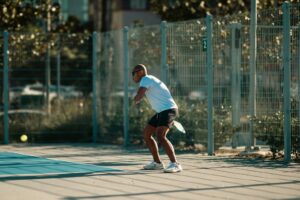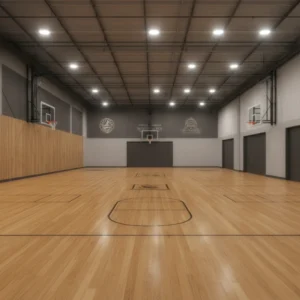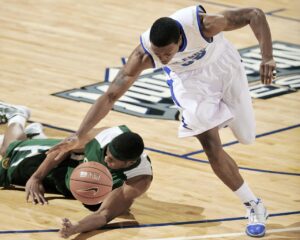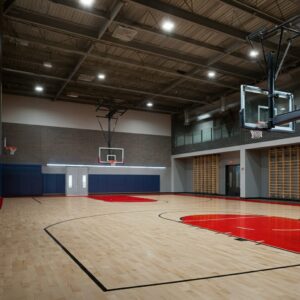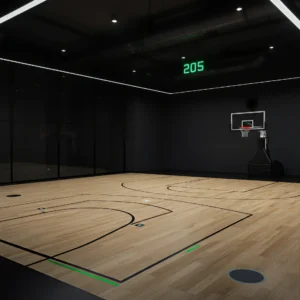Basketball is an exciting and fast-paced sport that demands speed and agility from players. However, one significant challenge players often face is the slippery nature of basketball courts.
Have you ever wondered why basketball courts are slippery and what causes this issue? In this article, we will delve into the reasons behind the slipperiness of basketball courts and explore potential solutions to make the game safer and more enjoyable for everyone involved.
Whether you’re a player, coach, or basketball enthusiast, understanding the factors contributing to slippery courts can empower you to navigate the game confidently.
Let’s take a closer look at why basketball courts are slippery.
Factors Contributing to Slippery Basketball Courts
When it comes to playing basketball, having a safe and well-maintained court is crucial. A slippery court surface is one of the most common issues affecting gameplay and increasing the risk of injury.
Slippery basketball courts hinder the players’ performance and pose a severe safety hazard. In this section, we will explore the factors contributing to slippery basketball courts and why addressing these factors is essential.
1. Moisture: Moisture is one of the primary culprits behind slippery basketball courts. Whether it’s due to rain, humidity, or even excessive sweating of the players, moisture on the court can create a slippery surface. When moisture accumulates on the court, it reduces friction between the shoes and the surface, making it easier for players to slip and slide.
2. Dust and Debris: Another factor that can contribute to slippery basketball courts is the presence of dust and debris. Over time, dirt, dust, leaves, and other forms of waste can accumulate on the court surface.
When players run, jump, and pivot on a dirty court, the debris can get trapped between the shoe soles and the court surface, reducing traction and increasing the risk of slips and falls.
3. Improper Cleaning: While regular cleaning is necessary to maintain a basketball court, improper cleaning methods or the use of inappropriate cleaning products can make the court surface slippery.
Specific cleaning agents may leave behind residue that creates a slippery film, and using too much water during cleaning can lead to excessive moisture on the court. It is important to use appropriate cleaning techniques and products specifically designed for basketball courts to ensure optimal traction.
4. Lack of Maintenance: A poorly maintained basketball court is more likely to become slippery. Neglected courts may develop cracks, uneven surfaces, or loose floorboards, all of which can affect the players’ balance and traction. Regular inspections, repairs, and resurfacing are essential to keep the court in good condition and reduce the risk of slips and falls.
5. Wrong Court Surface: The type of court surface can also influence its slipperiness. Different materials, such as wood, concrete, asphalt, or synthetic materials, have different levels of grip.
Some surfaces may become slippery due to wear and tear or inadequate maintenance. Choosing the right court surface and ensuring proper maintenance is crucial to providing players with an optimal playing experience.
6. COPO Macwood Surface: When it comes to sports courts, the choice of surface plays a crucial role in the overall playing experience. Different court surfaces offer varying levels of grip, which can significantly impact the players’ performance and safety.
Among the various options available, the COPO Basketball court floor stands out as one of the best choices for both indoor and outdoor courts. The COPO macwood indoor Basketball court is highly regarded for its innovative design and high-quality construction.
It is specifically engineered to provide exceptional grip and traction, allowing players to make quick movements and sharp turns without the fear of slipping. This surface is ideal for sports involving rapid direction changes, like basketball, tennis, and volleyball.
One of the key advantages of the COPO sports flooring is its durability. It is built to withstand heavy usage and can handle the demands of competitive play. This means your sports court will maintain its superior performance and appearance for an extended period, ensuring a worthwhile investment.
Another significant advantage of the COPO macwood surface is its low maintenance requirements. Unlike some other court surfaces that may become slippery due to wear and tear or inadequate maintenance, the COPO sports tiles are designed to be easy to clean and maintain. This means you can spend less time worrying about court upkeep and more time enjoying the game.

In addition to its impressive functionality, the COPO macwood floor also offers aesthetic appeal. Its sleek and polished appearance adds a touch of elegance to any sports facility, making it visually appealing for players and spectators.
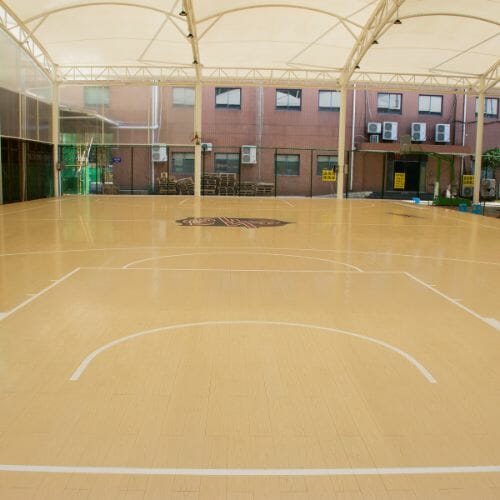
The COPO macwood surface excels in both aspects, providing players with an optimal playing experience while minimizing the risk of slips and injuries. Its superior grip, traction, durability, and low maintenance requirements make it ideal for sports courts.
7. Inadequate Shoe Traction: While not directly related to the court itself, the shoes players wear can significantly impact their traction. It’s easy to slip and fall with worn-out or inappropriate footwear. Encouraging players to wear proper basketball shoes with good traction can significantly reduce the risk of accidents.
Overall, Slippery basketball courts can cause a range of problems for players. Firstly, it increases the risk of injuries, such as sprained ankles, torn ligaments, or even more severe injuries from hard falls.
Additionally, players may find maintaining their agility and balance on the court challenging, which may affect their performance. Slippery conditions can lead to a decrease in confidence and hinder players from performing at their best.
How to Keep Basketball Courts From Slipping?
When it comes to maintaining a safe and playable basketball court, one of the biggest challenges can be dealing with a slippery surface. A slippery basketball court poses a risk to players and can affect the overall game experience.
To ensure a safe and optimal playing environment, it is crucial to implement strategies that reduce slipperiness on basketball courts. Here are some potential solutions.
1. Court Resurfacing: Regular resurfacing can restore the traction of the court. This involves stripping the old surface and applying a new material layer that provides a better grip. Choosing a surface material specifically designed for sports purposes and offers good traction even in wet conditions is crucial.
2. Anti-Slip Treatments: Applying anti-slip treatments to the court can significantly improve traction. These treatments can be applied to the existing surface and create a textured layer, enhancing grip and reducing the risk of slipping.
3. Proper Maintenance: Regularly cleaning and maintaining the basketball court is essential to prevent slipperiness. Dust, debris, and moisture can accumulate on the surface, making it slippery.
Sweep the court before and after each game or practice session to remove dirt and dust. Additionally, consider using a damp mop to eliminate any sticky materials or spills that can cause players to slip.
It is important to always dust mop before wet mopping to prevent dust and dirt from becoming trapped between the coatings of your basketball court. Traditional dust mops have been used for decades to clean basketball floors by removing dirt and debris.
Generally recommend using a microfiber mop. Microfiber mops can pick up more dirt and eliminate even the tiniest dust particles. Also, microfiber mops can be used for wet mopping with water, allowing you to achieve an extra clean floor.
4. Court Covers: In outdoor basketball courts, covering the court during periods of rain or excessive moisture can help prevent water accumulation, thus reducing slipperiness. Court covers are designed to protect the surface from external elements and maintain its integrity.
5. Automatic scrubbers: While auto-scrubbing your sports floor can be an efficient cleaning method, it’s important to exercise caution when using an auto scrubber.
While it can quickly remove stubborn stains and make your floor shine like brand new, excessive use of auto scrubbers can contribute to a slippery surface. Therefore, it’s essential to balance and avoid overusing automatic scrubbers.
6. Don’t mix cleaning products: Another crucial tip is to avoid mixing cleaners. Mixing several floor cleaners may seem like a convenient solution, but it can actually change the chemical balance of your floor’s surface, leading to an even slicker floor.
If you want to clean your basketball court properly, you should use only one recommended product. By following this tip, you can ensure that you maintain the surface’s chemical balance and prevent further slipperiness.
By addressing these factors and implementing proper maintenance and safety measures, basketball court owners can significantly reduce the risk of slips and falls, ensuring a safer and more enjoyable playing experience for all.
Conclusion
The slipperiness of basketball courts can be attributed to various factors. The smooth surface of the court, combined with dust, sweat, or excess moisture, can create a slippery surface that affects players’ traction and overall performance.
Additionally, the type of flooring, such as hardwood or synthetic materials, can also impact the level of slipperiness. It is crucial for players to take precautions, such as wearing appropriate shoes and maintaining proper court maintenance, to reduce the risk of accidents and injuries.
Understanding the reasons behind the slipperiness of basketball courts can help players and facility managers take necessary measures to ensure a safer and more enjoyable playing experience.
FAQs
Why Are Basketball Courts Slippery in the Winter?
Basketball courts can become slippery in the winter due to a few reasons. Firstly, cold temperatures can cause humidity to form on the court surface, making it slippery.
Moreover, moisture from rain, snow, or ice can seep into the court’s surface, creating a slick surface. These factors contribute to the slippery conditions on basketball courts during the winter.
Why Are Basketball Floors Slippery?
Basketball floors can become slippery due to various factors. One common reason is the accumulation of dust, sweat, and other substances on the surface, creating a slippery film. Moreover, improper cleaning or maintenance can contribute to a lack of traction.
Another factor is the type of finish or coating applied to the floor, as certain finishes may be more prone to becoming slippery. Lastly, environmental conditions such as humidity or moisture can also affect the slipperiness of basketball floors.
Are Basketball Floors Slippery?
Yes, basketball floors can be slippery. The level of slipperiness depends on various factors, such as the type of flooring material, its maintenance, and the presence of dust or moisture on the surface. Basketball players often wear proper footwear with good traction and grip to prevent slips and falls.
How Do I Make My Concrete Basketball Court Less Slippery?
You can use a traction-enhancing product or method to make your concrete basketball court less slippery. Applying a non-slip coating designed for concrete surfaces can provide a better grip.
Another option is to use a court conditioner, which helps to improve traction and reduce slipperiness. Additionally, regular cleaning and maintenance of the court can prevent the buildup of dirt and debris, contributing to slippery conditions.


